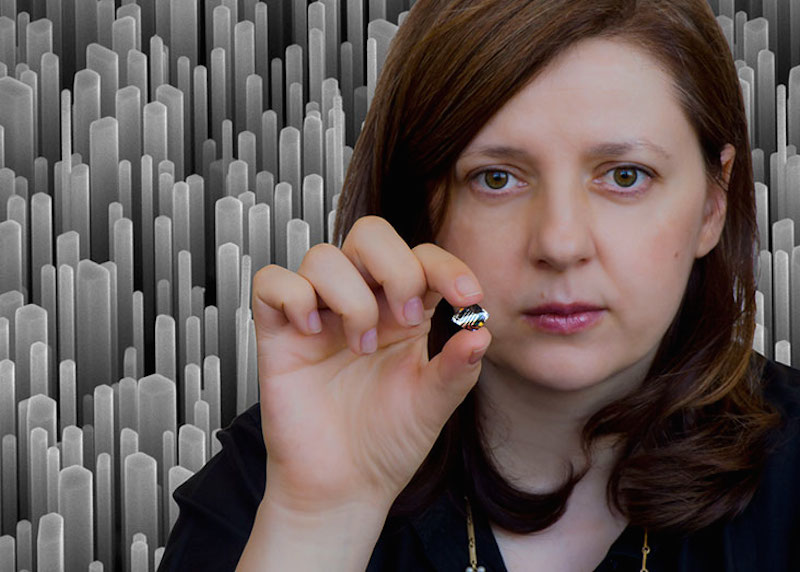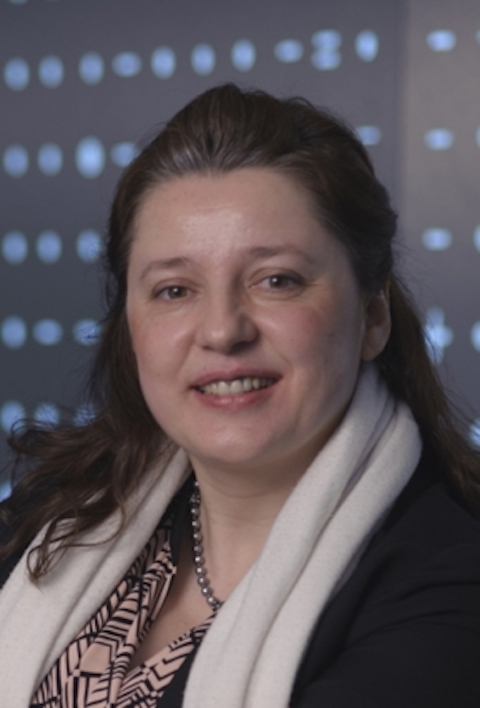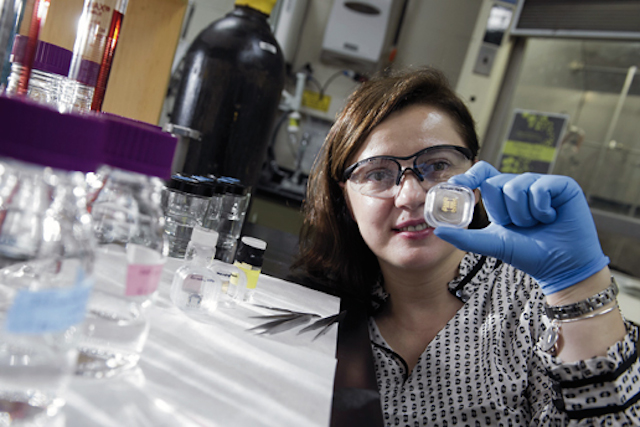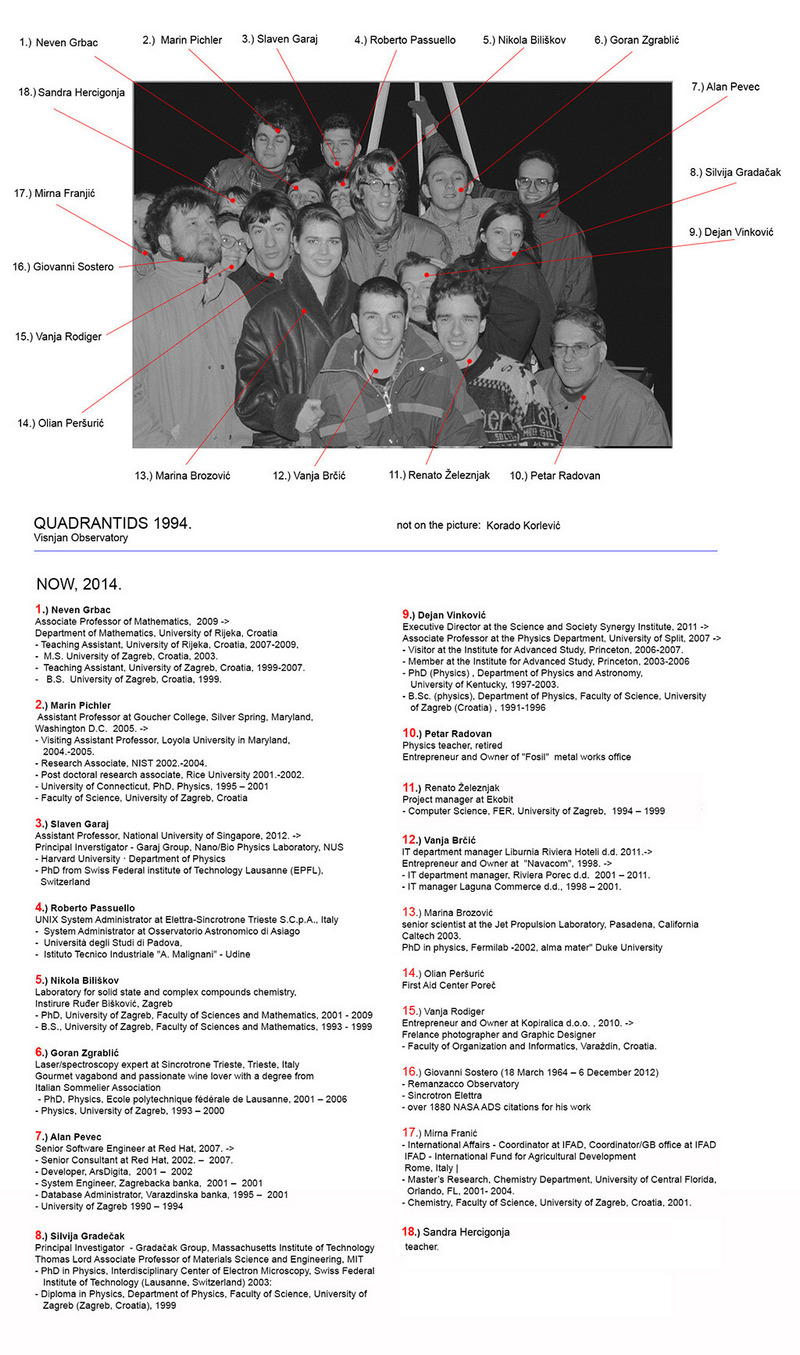 | Her solar cells could absorb and use more sunlight. Her light bulbs could last longer, and her thermoelectric devices could take heat that would be otherwise lost and turn it into energy. “We’re looking for more efficient, more environmentally friendly, and less expensive technology with new capabilities,” Gradečak says. Born in Vukovar, Croatia, she studied physics at the University of Zagreb and earned her PhD in Physics at the Swiss Federal Institute of Technology in Lousanne. |

Silvija Gradecak: Synthesis of Nano Structured Materials
Principal Investigator Silvija Gradecak Thomas Lord Associate Professor of Materials Science and Engineering  Education 2003: PhD in Physics Interdisciplinary Center of Electron Microscopy, Swiss Federal Institute of Technology (Lausanne, Switzerland) 1999: Diploma in Physics Department of Physics, Faculty of Science, University of Zagreb (Zagreb, Croatia) Research Experience 2004-2006: Postdoctoral Fellow Professor Charles M. Lieber group, Department of Chemistry and Chemical Biology, Harvard University (Cambridge, Massachusetts) 2004: Research Associate Institute of Quantum Electronics and Photonics, Swiss Federal Institute of Technology (Lausanne, Switzerland), Professor Marc Ilegems 1999-2003: Graduate Student Interdisciplinary Center of Electron Microscopy, Swiss Federal Institute of Technology (Lausanne, Switzerland), Professor Pierre Stadelmann 1999: Undergraduate Student Laboratory for Thermal Conductivity Investigation, Institute of Physics (Zagreb, Croatia) 1998-1999: Research Assistant Laboratory for Structural Investigation, Department of Physics, Faculty of Science, University of Zagreb (Zagreb, Croatia) Awards and Achievements 2013: Promoted to tenured Associate Professor, effective July 1, 2013 2012: Nano Letters Young Investigator Lectureship 2012: Promoted to Associate Professor, effective July 1, 2012 2010: Thomas Lord Career Development Chair 2008: NSF CAREER (Faculty Early Career Development) Award 2007: 3M Innovation Award 2007 2007: MIT Alumni Fund Award for Teaching and Education Enhancement 2006: Merton C. Flemings Career Development Chair 2004: Swiss National Science Foundation Fellowship for Prospective Researchers 2003: Diploma in Entrepreneurship Course at the CREATE Branco Weiss Chairs of Entrepreneurship and Innovation, Swiss Federal Institute of Technology (Lausanne, Switzerland) 2002: Organization of the scientific expedition Electrophonic Fireball Project, Terra Alta region, Spain 2001: Scholarship of Swiss Society for Optics and Microscopy 1998: Organization of the scientific project International Leonid Watch – Croatia, Ulan Bator, Mongolia 1996: Dean's Prize for the Best Student Project at University of Zagreb in 1995/96 Academic Year (Zagreb, Croatia) 1996: Scholarship of the City Council of Zagreb (Zagreb, Croatia) Source web.mit.edu/gradecakgroup More information at [PDF] |
Silvija Gradecak: Tuning Nano Structured Materials for Light Emitting Diodes
Silvija Gradecak: Nano Structured Solar Cells
 Ă‚Ă‚Ă‚Ă‚Ă‚Â
Ă‚Ă‚Ă‚Ă‚Ă‚Â Nanoscale work yields big results Silvija Gradečak'€™s nanoscale work creates big-scale results that could transform energy production, storage, and lighting. An avid amateur astronomer during her childhood in Vukovar, Croatia, Silvija Gradečak, Associate Professor in Materials Science and Engineering, was not content observing the physical world only from a distance: "I discovered what I really liked about science were experiments, and having the ability to make something with my hands," she says. Today, handling the smallest elements in nature, Gradečak is generating large-scale results that may transform energy production, storage, and lighting. Her enthusiasm for both basic and applied research will help to power MIT.nano, the Institute€™s $350 million nanoscale laboratory now under construction. Gradečak looks forward to working "with people from different backgrounds, advanced nanofabrication tools, and the seamless integration of the technologies needed to work on these problems." At the Swiss Federal Institute of Technology, where Gradečak pursued her doctorate, an electron microscope revealed a new terrain ripe for exploration and manipulation. "€śI saw individual atoms for the first time, and came to realize that having the ability to arrange them on the nanoscale is a powerful tool,"€ť she says. "There were so many new problems available to work on. All kinds of possibilities emerge when you have the capability to develop materials with unique structure and properties not found in nature." Teasing out these properties becomes possible when examining materials at the nanoscale (a nanometer is one-billionth of a meter, and nanoscale materials run one to 100 nanometers in size). During graduate school, Gradečak zeroed in on gallium nitride, GaN, a synthetic compound used by the semiconductor industry that turned out to feature some extraordinary optical properties: If the composition of GaN is altered at the nanoscale, the compound can produce light ranging from the ultraviolet to the infrared. As a young researcher investigating nanoscale defects in GaN that changed the compound's behavior, Gradečak "€śopened up a new world," she says. "We all have to find a niche, our passion, and learning that I could design materials, tune their properties and emissions -€” this ability was amazing to me." Gradečak was especially fascinated by the wealth of potential optical and electrical applications for these nanoscale materials. GaN and similar semiconducting compounds are capable not just of emitting light at a range of wavelengths, but of conducting electricity and heat more efficiently, too. Gradečak set about harnessing the power of nanoscale compounds. She developed a unique repertoire of laboratory methods that involve manipulating compounds in their vapor phase in a growth chamber. Inside, atoms take root on substrates in particular configurations based on Gradečak's desired outcomes. In one venture, Gradečak created nanowires, slender, solid fibers composed of nanoscale semiconductor materials, that can be grown on varied surfaces such as silicon or flexible polymers. Of infinitesimal diameter, these nanowires are essentially one-dimensional objects, and because they can be millions of times longer than they are wide, they are ideally suited for transmitting energy in the form of electricity, heat, and light. One signature application to emerge from this nanowire research is a new and different kind of light-emitting diode (LED). Gradečak'€™s device more closely approximates sunlight’s red and green wavelengths than current LED technologies. In addition, instead of utilizing expensive materials such as sapphire as a growth medium, as is the typical practice of current manufacturers, Gradečak's nanowire-based LEDs can be grown on abundant, inexpensive substrates, including flexible plastics. Her invention may prove much more economical for home and industry consumers. Another key development from Gradečak'€™s lab is a solar cell made from zinc oxide nanowires embedded with tiny quantum dots -€” nanocrystals made from a semiconductor material that are so small they essentially have no dimension. While the device does not yet convert solar energy to electricity as efficiently as today's silicon-based solar cells, Gradečak notes, "Our devices are transparent and flexible, and in just a few years, we've improved efficiency of our cell by two orders of magnitude; this is an amazing accomplishment." October 24, 2014 Leda Zimmerman Source mitei.mit.edu |
Silvija Gradecak: Increasing Efficiency of Thermoelectric Devices
INTERVIEW in Croatian: Silvija Gradečak, MIT
Developing New Light and Energy Technologies Silvija Gradečak customizes nano-scale systems for large-scale impact in light and energy. Silvija Gradečak has big intentions for small ingredients. The associate professor of materials science and engineering focuses on energy conversion and light harvesting through the use of nanomaterials. It'€™s in these microscopic sizes that she has the chance to customize individual components, meld the parts, and create a new kind of material. The work is not without its challenges. There'€™s the need to understand and delicately balance pieces on the atomic scale and then be able to take discoveries made in the lab and apply them to a bigger workspace. But there'€™s also the possibilities. Her solar cells could absorb and use more sunlight. Her light bulbs could last longer, and her thermoelectric devices could take heat that would be otherwise lost and turn it into energy. "We'€™re looking for more efficient, more environmentally friendly, and less expensive technology with new capabilities,"€ť Gradečak says. Working in Closed Spaces One benefit of using nanomaterials is their scale, Gradečak says. The confined dimensions are ideal for tailoring the properties of electrons, photons and protons, and provide the chance to engineer individual nanoscale components, and, using synthesis methods, control their properties and performance. For example, by changing the size and composition of nanomaterials, Gradečak can change a semiconductor's energy band gap, allowing photons of different energies to be absorbed into a new type of solar cell. The research is in its early stages, but Gradečak says the potential exists for various light harvesting applications, specifically when it comes to efficiency. As it stands, within one hour, the earth receives enough sunlight for one year'€™s worth of energy. The problem is that only a portion of the sunlight is used with current solar technology. Gradečak'€™s cells could be customized to absorb different wavelengths and composed of several types of nanomaterials -€” nanowires, nanoparticles, and graphene -€” which each have a specific function in the new type of solar cells. The devices could be put onto buildings and other surfaces to take into account needs of both a specific application and a given geographic location. Adding to that, the new solar cells are flexible, lightweight and transparent€” cells wouldn't be limited in their placement, but now could be used on curved and moving surfaces, such as cars and clothing. "€śHarvesting solar light would become a matter of convenience,"€ť she says. Playing with Colors Another of her projects focuses on developing light emitting diodes. Current sources of artificial light obviously work, but they also could last longer and be more efficient. As Gradečak says, they generate more heat than light. Light bulbs based on semiconducting diodes do exist and they are already more efficient, but they're also more expensive. Nanowires could hold the solution. They can be grown on a variety of substrates, thereby lowering the costs, and they don'€™t contain the defects that are inherent in current technology. The challenge with manufacturing anything with light is how to produce it with the same colors and intensities as the sun and have it be comfortable for the human eye. In Gradečak'€™s lab, she'€™s designing a device that is able to emit greens, blues and reds in different ratios. With nanotechnology, she can tune the band gap of the materials and consequently change the wavelength. Simultaneously, she'€™s working on technology that produces blue light that is transformed into reds and greens in different proportions with the use of phosphorus materials, which absorb blue light and re-emit it in a different color. The overlying challenge with making a successful transition is understanding the nano-components and making them work together. Gradečak has developed a characterization technique that can determine how changing the composition and morphology of the nanomaterials changes the optical properties. Or as she says, "What are the knobs that we need to tune during synthesis to obtain specific functionality." Along with that, Gradečak is looking at ways to enhance flexibility and efficiency of solar cells, particularly through transparent electrodes. This is where her use of graphene plays a key role. Currently, indium tin oxide is the industry standard, but it'€™s expensive. Graphene has one layer of carbon atoms, and it has the necessary conductivity and flexibility. The question that Gradečak continues to explore is how to deposit materials onto graphene, have them interface and produce a workable solar cell. Controlling Temperature One of her other projects involves developing a thermoelectric device. Similar to a solar cell, this would harness thermal energy and convert it into electricity. As an example, a car engine generates a high temperature, but most of it goes to waste. Her hope is to capture that heat and ultimately use it to power the vehicle’s electrical systems. Taken a step further, solar cells could be placed on that same car and be used to heat or cool it. "€śIt'€™s a development that's well into the future but one that would open up new ways of how we think about energy," Gradečak says. With all her work, an essential aspect is mastering the issue of scale. She's working with atoms of different materials. Each one could be customized, but playing with one can affect others in untold ways. The correct interaction and balance can be found, but that'€™s just one piece of the equation. The next and necessary step in the process is to take a finding in the lab that works at one square inch and translate it to real-life, practical, industry-needed size, all while preserving the quality and efficiency. "Nanomaterials offer exciting opportunities, and understanding how to translate their properties to the macroscopic scale holds the key toward scalability and new energy applications that currently do not exist,"€ť Gradečak says. August 21, 2014 Steve Calechman Source mitei.mit.edu |
Silvija Gradečak at the Viąnjan Observatory in Croatia In the early 1990s, as a child, Silvija Gradečak lived in Viąnjan, a small town in Istrian peninsula on the south-west of Croatia. She attended the famous Viąnjan Observatory directed by Korado Korlević, where her earliest interest for science has been created and developed. |

Formated for CROWN by Darko ®ubrinić
Distributed by www.Croatia.org . This message is intended for Croatian Associations/Institutions and their Friends in Croatia and in the World. The opinions/articles expressed on this list do not reflect personal opinions of the moderator. If the reader of this message is not the intended recipient, please delete or destroy all copies of this communication and please, let us know.